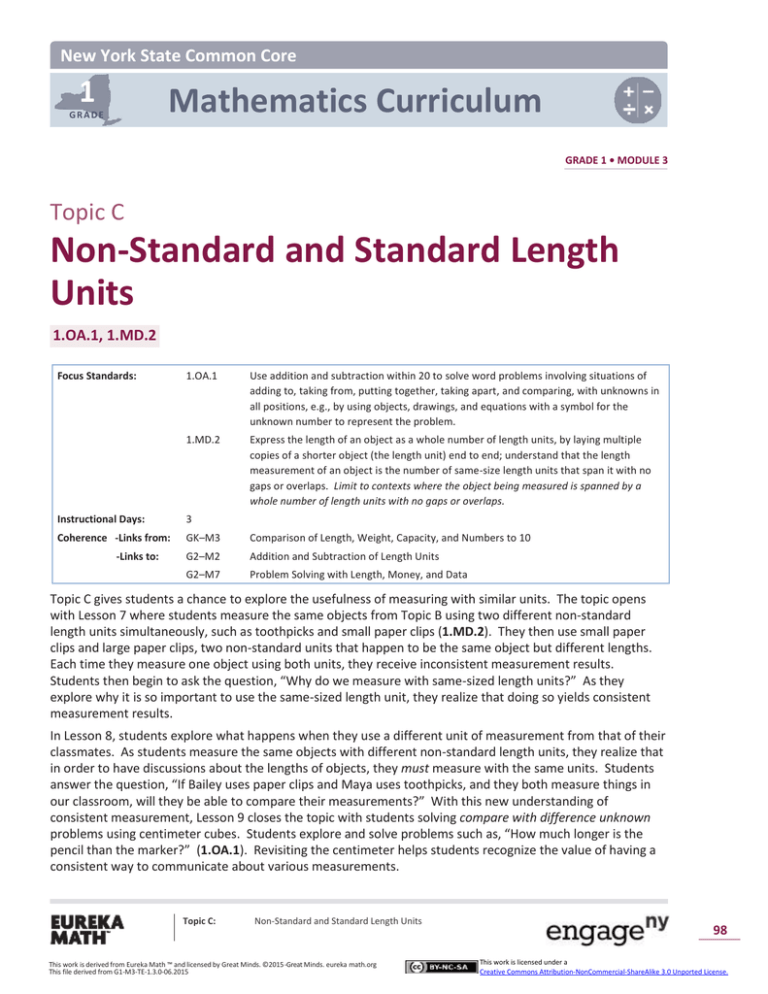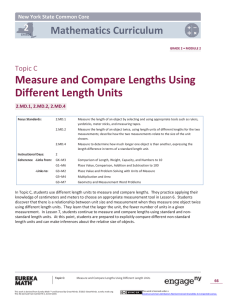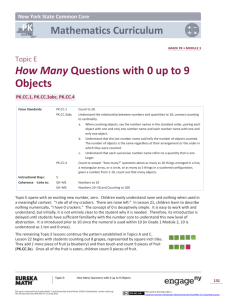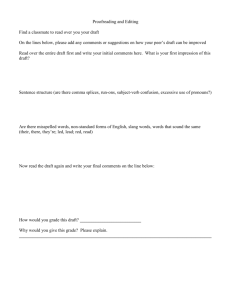Grade 1 Mathematics Module 3, Topic C
advertisement

New York State Common Core 1 Mathematics Curriculum GRADE GRADE 1 • MODULE 3 Topic C Non-Standard and Standard Length Units 1.OA.1, 1.MD.2 Focus Standards: 1.OA.1 Use addition and subtraction within 20 to solve word problems involving situations of adding to, taking from, putting together, taking apart, and comparing, with unknowns in all positions, e.g., by using objects, drawings, and equations with a symbol for the unknown number to represent the problem. 1.MD.2 Express the length of an object as a whole number of length units, by laying multiple copies of a shorter object (the length unit) end to end; understand that the length measurement of an object is the number of same-size length units that span it with no gaps or overlaps. Limit to contexts where the object being measured is spanned by a whole number of length units with no gaps or overlaps. Instructional Days: 3 Coherence -Links from: GK–M3 Comparison of Length, Weight, Capacity, and Numbers to 10 G2–M2 Addition and Subtraction of Length Units G2–M7 Problem Solving with Length, Money, and Data -Links to: Topic C gives students a chance to explore the usefulness of measuring with similar units. The topic opens with Lesson 7 where students measure the same objects from Topic B using two different non-standard length units simultaneously, such as toothpicks and small paper clips (1.MD.2). They then use small paper clips and large paper clips, two non-standard units that happen to be the same object but different lengths. Each time they measure one object using both units, they receive inconsistent measurement results. Students then begin to ask the question, “Why do we measure with same-sized length units?” As they explore why it is so important to use the same-sized length unit, they realize that doing so yields consistent measurement results. In Lesson 8, students explore what happens when they use a different unit of measurement from that of their classmates. As students measure the same objects with different non-standard length units, they realize that in order to have discussions about the lengths of objects, they must measure with the same units. Students answer the question, “If Bailey uses paper clips and Maya uses toothpicks, and they both measure things in our classroom, will they be able to compare their measurements?” With this new understanding of consistent measurement, Lesson 9 closes the topic with students solving compare with difference unknown problems using centimeter cubes. Students explore and solve problems such as, “How much longer is the pencil than the marker?” (1.OA.1). Revisiting the centimeter helps students recognize the value of having a consistent way to communicate about various measurements. Topic C: Non-Standard and Standard Length Units This work is derived from Eureka Math ™ and licensed by Great Minds. ©2015 -Great Minds. eureka math.org This file derived from G1-M3-TE-1.3.0-06.2015 98 This work is licensed under a Creative Commons Attribution-NonCommercial-ShareAlike 3.0 Unported License. Topic C 1•3 NYS COMMON CORE MATHEMATICS CURRICULUM A Teaching Sequence Toward Mastery of Non-Standard and Standard Length Units Objective 1: Measure the same objects from Topic B with different non-standard units simultaneously to see the need to measure with a consistent unit. (Lesson 7) Objective 2: Understand the need to use the same units when comparing measurements with others. (Lesson 8) Objective 3: Answer compare with difference unknown problems about lengths of two different objects measured in centimeters. (Lesson 9) Topic C: Non-Standard and Standard Length Units This work is derived from Eureka Math ™ and licensed by Great Minds. ©2015 -Great Minds. eureka math.org This file derived from G1-M3-TE-1.3.0-06.2015 99 This work is licensed under a Creative Commons Attribution-NonCommercial-ShareAlike 3.0 Unported License.






